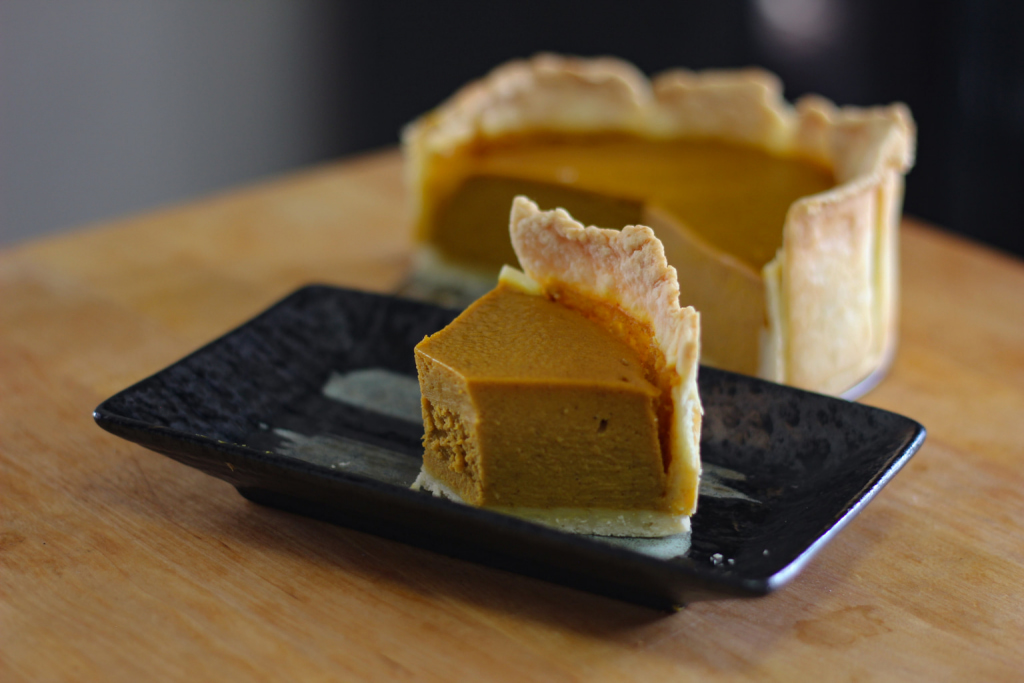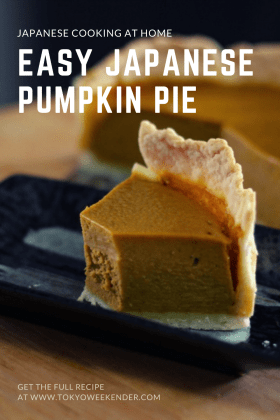While most wouldn’t peg pumpkin as a Japanese ingredient you’ll be surprised at how much this vegetable makes an appearance on the Japanese dinner table. From tempura and soups to stews and bento buffers, this rock-solid vegetable is an all arounder in the culinary boxing ring. Let’s take a closer look at the seasonal ingredient: kabocha, or Japanese pumpkin, and some of the ways we can incorporate it into our autumn diet, including a lesson on how to make homemade pumpkin pie in Japan.
Kabocha no Nimono

Nimono is the art of cooking food by boiling or stewing it in a variety of flavors – think of a more controlled version of oden. In this dish, we’ll boil pumpkin with a combination of different Japanese spices to create a side dish worthy of any dinner party.
To create this delicious stewed pumpkin dish you’ll need the following ingredients:
- Water 300ml
- Pumpkin 300g
- Soy sauce 1 tbsp
- Sugar 1 tbsp
- Salt ¼ tsp
- Sake 1 tbsp
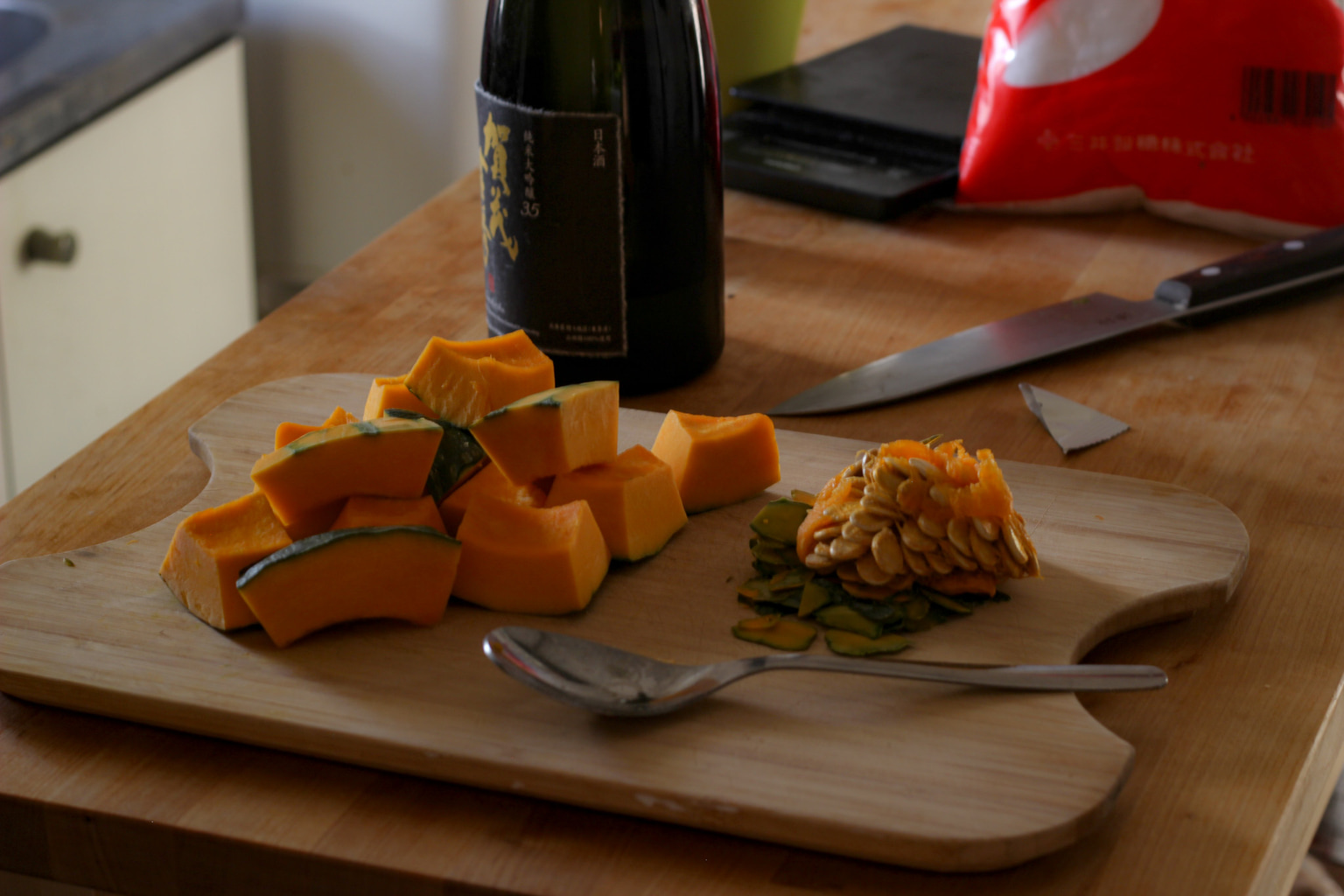
With the above ingredients, one can create a small portion of kabocha nimono enough for around 3-5 people. For those confused at the supermarket trying to figure out which pumpkin is around 300g, usually, the pumpkin that has been pre-cut into ¼ weighs around 300g.
When it comes to preparing the pumpkin, a sharp knife and caution is needed. For those who have never handled pumpkin outside of a jack-o-lantern carving capacity, cleanly cutting through it can occasionally be challenging. Once you have your pumpkin cut into medium-sized chunks start on your broth. In a medium to small size pot, heat up your water. Once the water is simmering add your dashi and allow it to fully dissolve before you add any of the additional seasonings. Once dissolved add the rest of your ingredients minus the pumpkin and stir until combined, depending on your pot size the water may not even reach halfway up the pot but don’t worry as we aren’t trying to boil the pumpkin to death. As long as the pumpkin is 80% of the way submerged you’ll be fine.
Once all the seasonings are mixed in well, add your pumpkin to the mixture and turn the heat down low. When making nimono a low heat is your greatest ally as it gives whatever you are stewing, in this case pumpkin, enough time to soak up all the flavors of the broth before it cooks completely. Keep the pumpkin simmering on a low heat for around 20-30minutes or until the pumpkin is easily pierced with a fork. Remove from the heat and serve. The broth that the pumpkin was cooked in isn’t for drinking and can be tossed out once the pumpkin is complete.
Pro tip: Leave the skin on the pumpkin. Pumpkin skin becomes soft after its done stewing and adds an extra layer of texture to the dish.
Kabocha Korokke
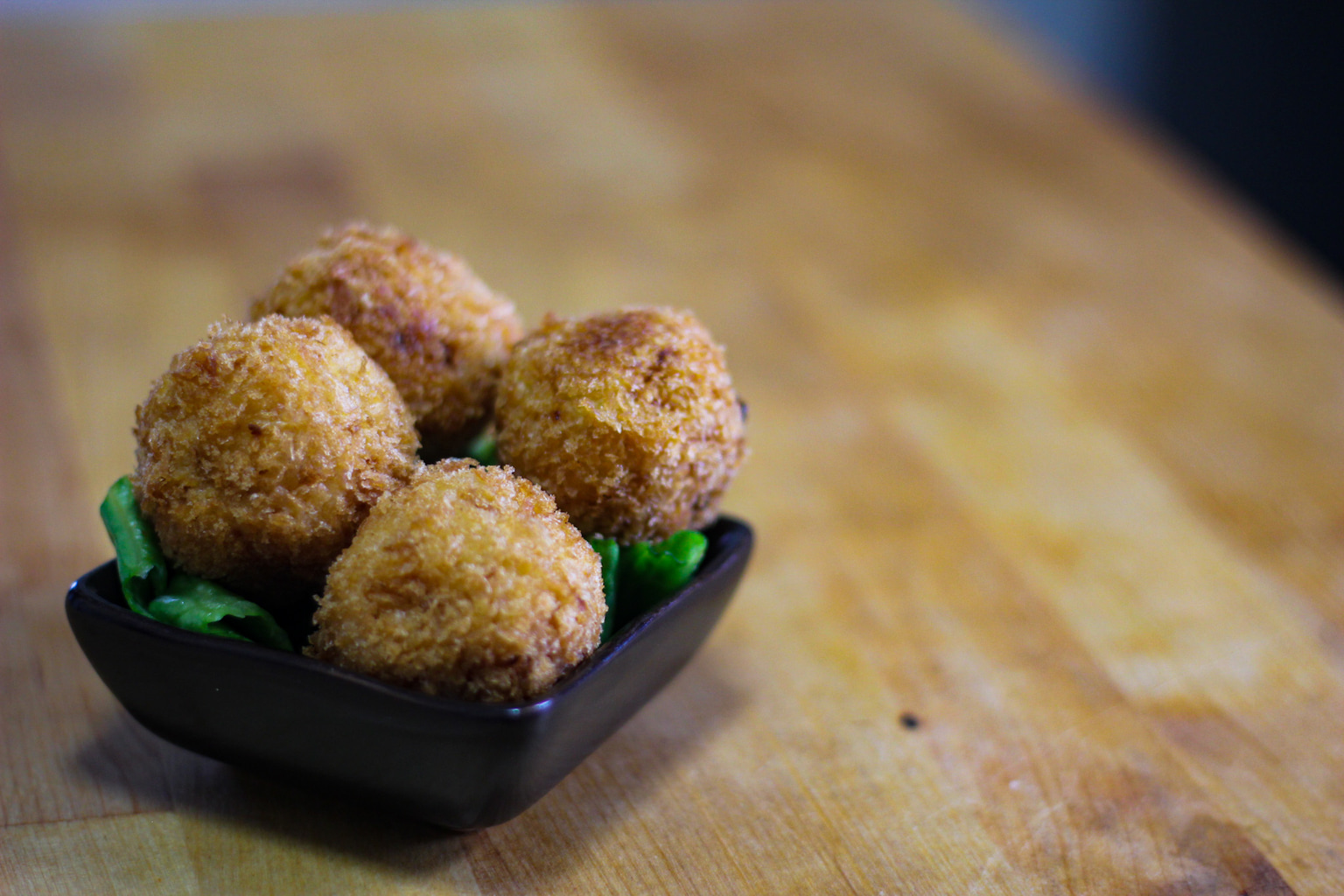
Working with hot oil can be a little scary for some, especially for those who don’t cook as much as they’d like. But we must remember this single rule of cooking: fried things are always delicious. And these pumpkin korokke, if nothing else, prove that rule.
The pumpkin korokke is a twist on its potato-based brethren and thus creating one of these in the kitchen is pretty straightforward. First, we’ll need to prepare a few ingredients, for this recipe you’ll need:
- Pumpkin 300g
- Onion 1 small
- Bacon 20g (or any type of meat)
- Butter 1 tbsp
- Oil (for frying)
- Flour for coating
- 1 Egg
- Salt and pepper
- Panko crumbs
Start by cutting the pumpkin into slightly larger than bite-size pieces. Take your pieces and place them into a steamer until they are piercable with a fork. You can also boil the pumpkin as long as they become soft. If you don’t have a steamer or want to boil them, a great trick is to place the pumpkin in a bowl with a tiny bit of water and then cover the bowl with plastic wrap, place the bowl in the microwave to steam, checking every 40 seconds to a minute to make sure the pumpkin isn’t overcooking.
While your pumpkin is steaming or boiling, slice your onions into small pieces and place them into a hot pan with a little butter to fry. Once the onions gain a little color, add your chosen meat into the pan. Minced meat or bacon usually works best with pumpkin korokke. I personally prefer bacon as the contrast with the sweet pumpkin. After your meat onion mixture has finished cooking, place it into a separate bowl to be combined with the softened pumpkins.
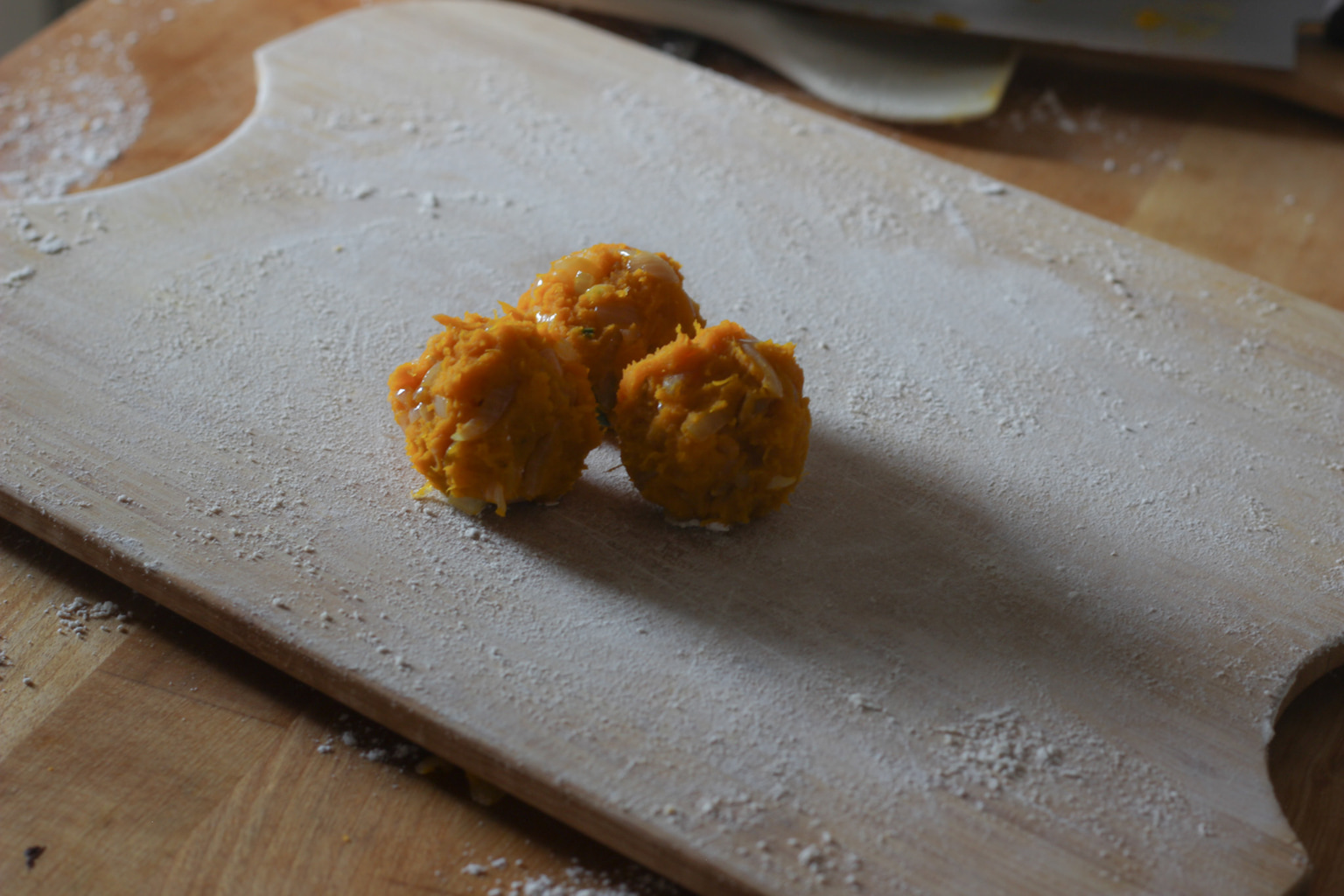
Mash and mix the pumpkin in with the onion meat mixture until it forms an almost mash potato consistency adding salt and pepper as you mix. After the mixture is combined make slightly larger than bitesize balls with the pumpkin mixture and then place them in the fridge to firm up for around 10-15 minutes. At this stage, flour will be your best friend as the sticky mixture will not want to let go of your fingers as you try and form perfect balls.
After around 15 minutes remove the pumpkin balls from the fridge and prepare for frying. Coat the balls in flour and then dip them in a beaten egg before coating the balls in panko crumbs and setting them aside to be fried. Once all the balls are prepared, heat up some oil, enough to cover the balls once submerged, and start frying the korokke a few at a time. It’s important not to crowd the pot at this stage. Once the korokke are golden brown, place them on a wire rack to cool and hit them with a little salt. Perfect pumpkin Korokke. While delicious alone, the round pumpkin powerhouses are also amazing when paired with a little tonkatsu sauce.
Pro tip: When making kabocha korokke, keeping the skin on or off doesn’t matter as the pumpkin skin is edible. Including the skin will just give the final product a darker color.
Kabocha Tempura
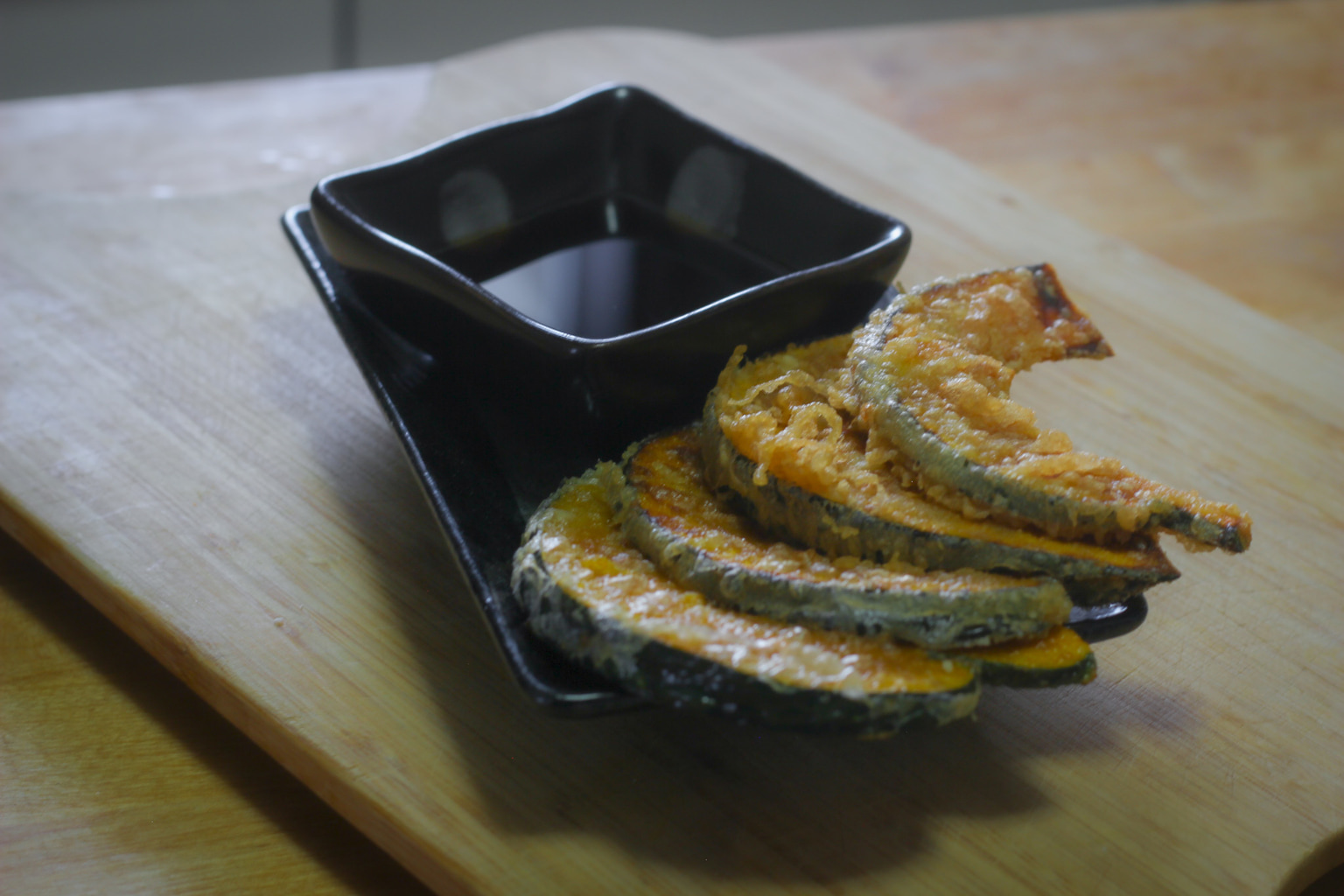
A Japanese staple, tempura can be a tricky dish to recreate at home. From the tempura batter to the temperature of the oil, tempura has a few places where mistakes can potentially be made, but don’t panic as they say practice makes perfect. For kabocha tempura you will need:
- Pumpkin 300g
- 1 Egg
- Ice water 100ml
- Potato starch 15g
- All-purpose flour 45g
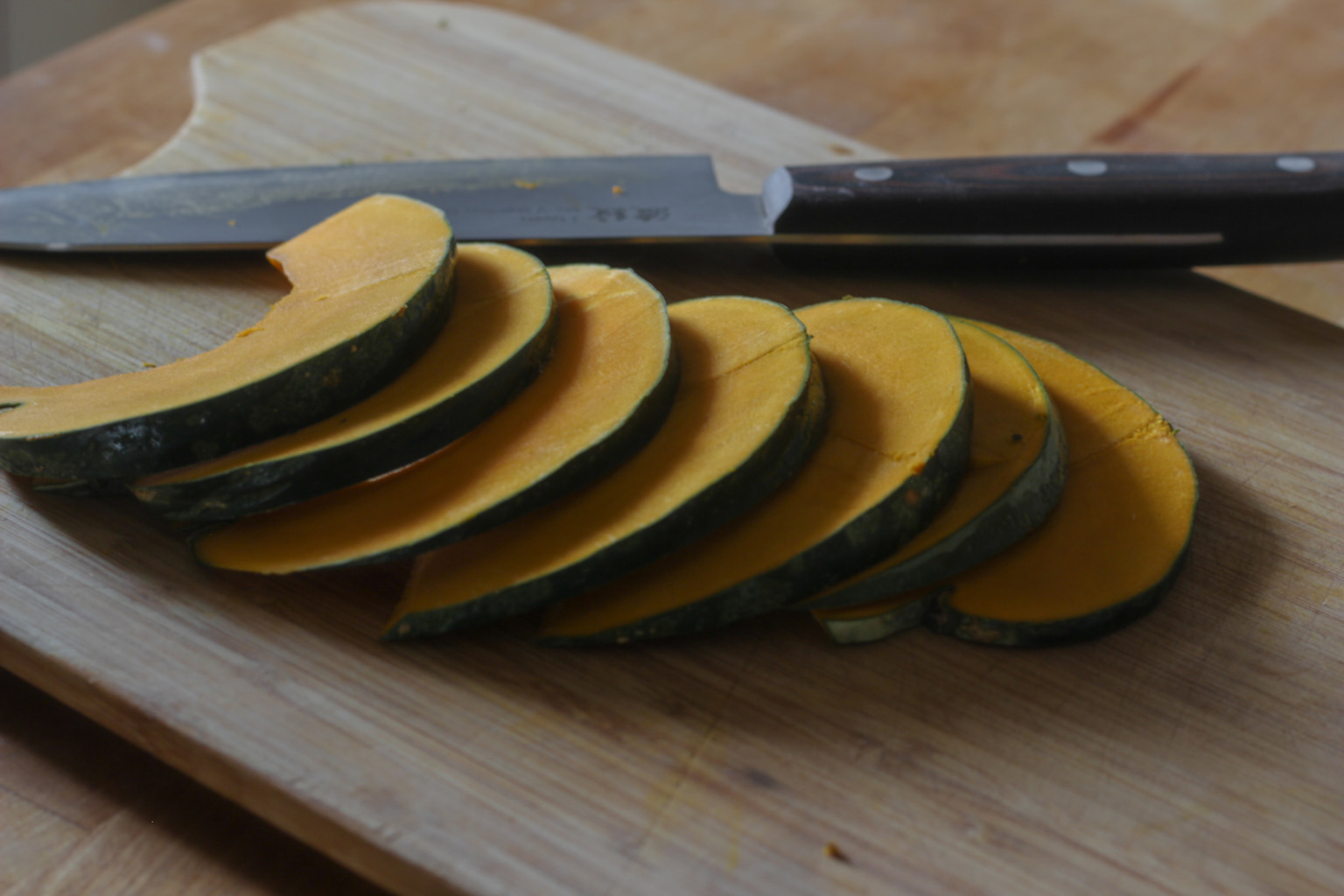
Take your pumpkin and slice it into crescent moon shapes. A sharp knife and a little skill is required to cut the pumpkin into crescent slices, but the key thing to remember here is don’t rush. Pumpkin, and other members of the squash family, can be incredibly tough to cut and the last thing we want is to cut something other than pumpkin. Once the pumpkin has been sliced into manageable slices let’s start making the tempura mix.
For the tempura batter, add 1 egg to a bowl and slowly whisk in your ice cold water. Once the egg and water mixture have been fully incorporated, slowly sift the flour into the mixture. You want to add the flour bit by bit as dumping all the flour in at once will cause lumps to form, which will ruin the consistency of the batter. Once the flour is added do the same with the potato starch, slowly sifting it into the batter.
Temperature control is essential when cooking tempura. It’s said that the perfect tempura is made between 170-180 degrees C°. For those who have a kitchen thermometer now’s the time to use it. For the rest of us, we’ll just have to guess. Once the oil is hot place, the pumpkin into the batter and then into the hot oil. It’s important not to overcrowd the pot as that will lead to greasy undercooked tempura. Once the tempura has become a golden brown place it on a wire rack to cool. Repeat until all the pumpkin has been cooked and served with the dipping sauce of your choice.
Pro tip: Using the same batter you can tempura a whole bunch of other vegetables from peppers to shiso. Go wild in the kitchen and see what other vegetables suit this cooking method.
Homemade Pumpkin Pie
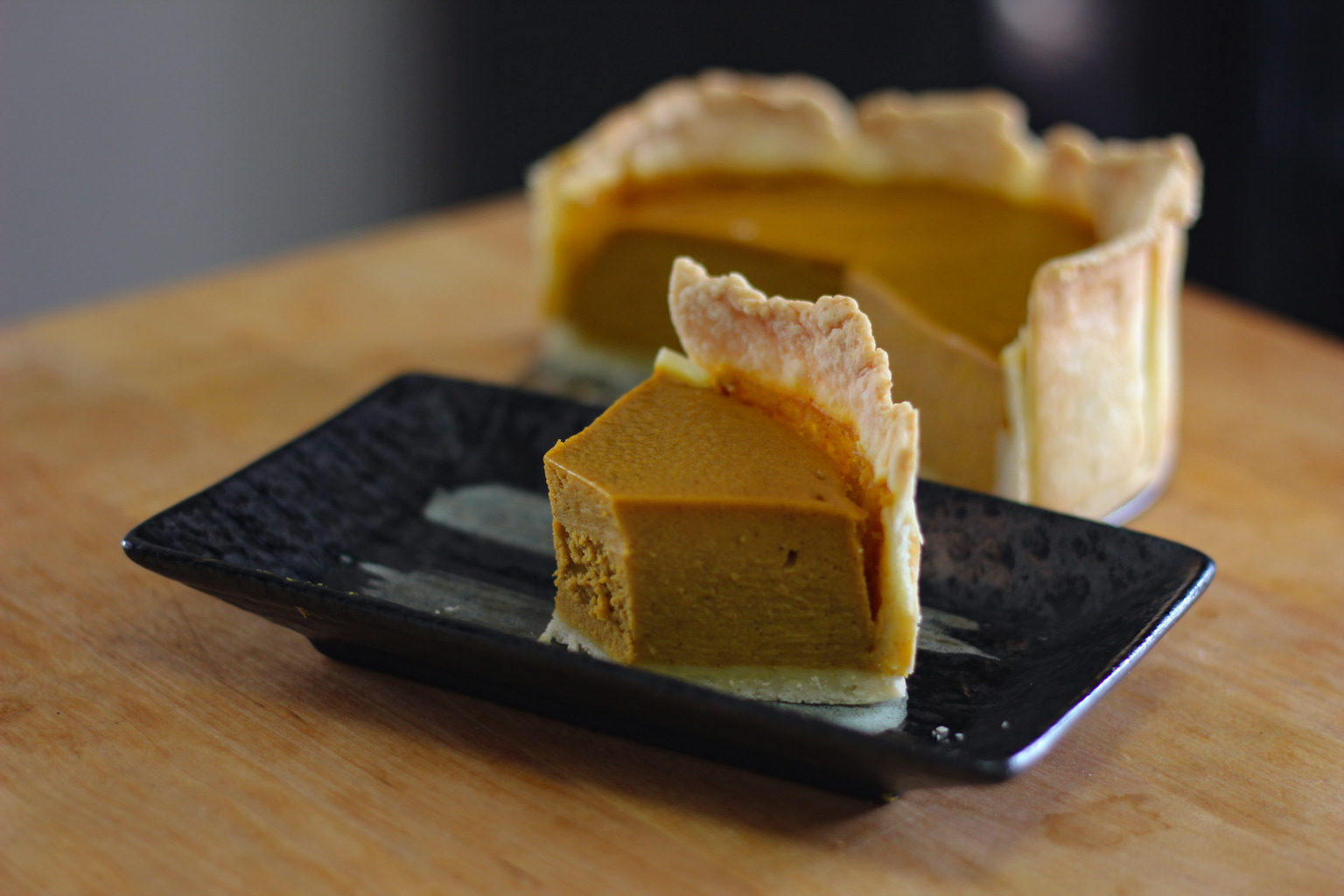
Pumpkin pie is an American staple, and so it’s a little strange to find it on a list of Japanese recipes. But as we go from summer to autumn, sometimes a little home comfort is all we need. Traditionally pumpkin pie isn’t made with Japanese pumpkin and so in this dish, we will give a little Japanese spin to this American classic. For this recipe youll need:
- Pumpkin 450g
- 2 tbsp pumpkin spice (1 tbsp cinnamon, 2 tsp nutmeg, ½ tsp ginger, ½ tsp cloves and ½ tsp allspice)
- Unsalted butter 30g
- Sugar 30g
- 1 Egg yolk
- 2 Eggs
- Brown sugar 72g
- Salt ½ tsp
- Double cream 200ml
Start by cutting your pumpkin into manageable pieces and using your preferred cooking method, steaming or boiling seems to work best, cook your pumpkin until they are soft. While the pumpkin is softening, this is the perfect time to focus on the pumpkin spice. In a separate bowl mix together 1 tablespoon of cinnamon, 2 teaspoons of ground ginger and half a teaspoon of allspice, ground cloves and nutmeg. This should yield you around 2 tbsp of pumpkin spice. Of course, you can tweak the recipe to find the blend that best works for you but for those looking for a base level pumpkin spice, look no further.
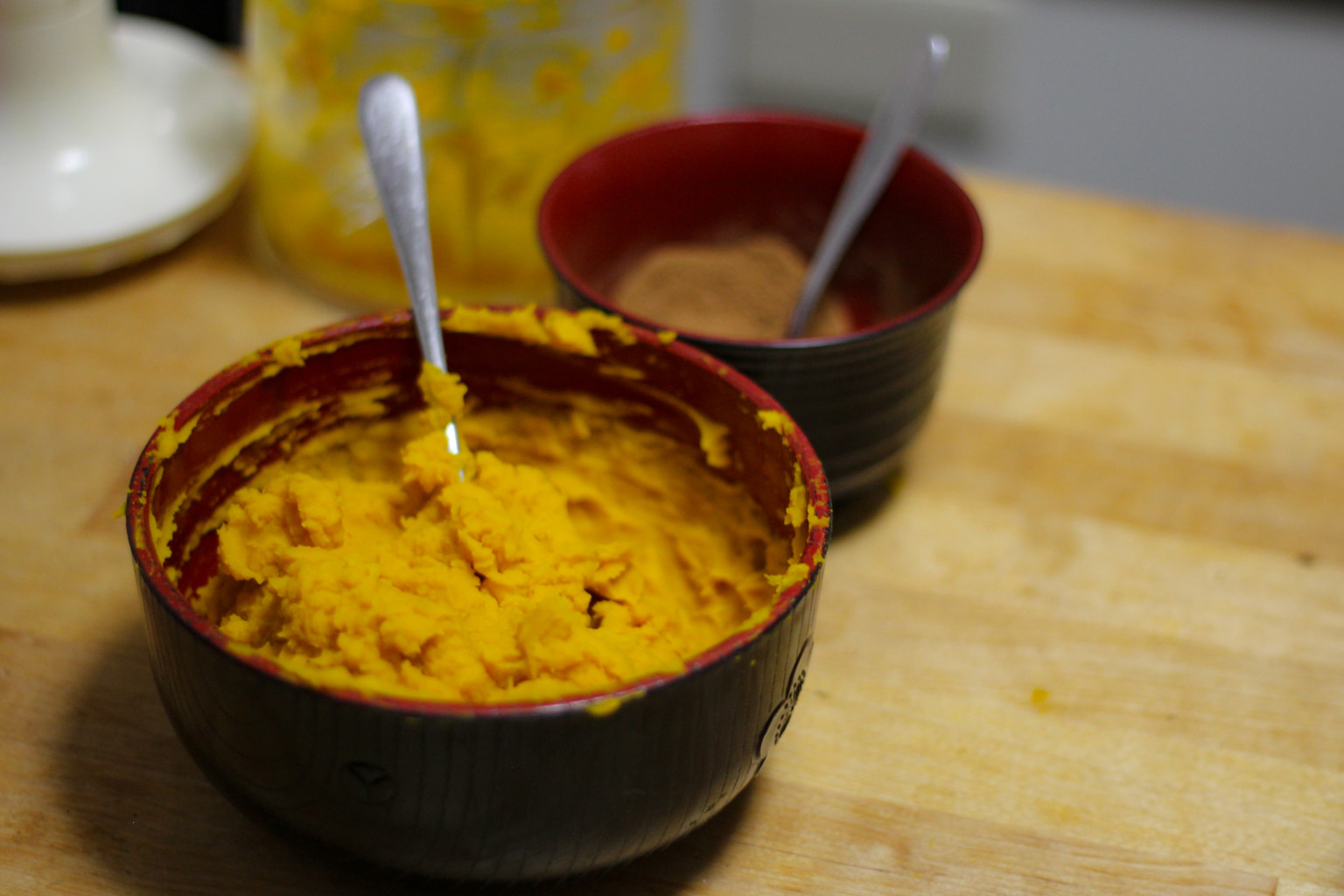
Once the pumpkin is soft remove the skin and place the pumpkin in a separate bowl to be smoothed out. If you have a food processor this is the best time to use it. Fill the food processor with the pumpkin and in short 5-8 second bursts blend the pumpkin until it has the same consistency as a very smooth mash potato. For those without a processor, the same consistency can be achieved using a fork, a spoon or even a potato masher.
In a large bowl, whisk together your unsalted butter and white sugar until combined. Once combined add your eggs and egg yolk and repeat the process. The mixture should be an off-yellow color at this stage. Add your pumpkin paste to the egg mixture and slowly whisk it together until the contents of your bowl is bright orange and smooth. At this stage, we want to add the rest of our dry ingredients to the bowl, our brown sugar, salt and most importantly our pumpkin spice. Mix well before slowly adding in the double cream and whisking until combined.
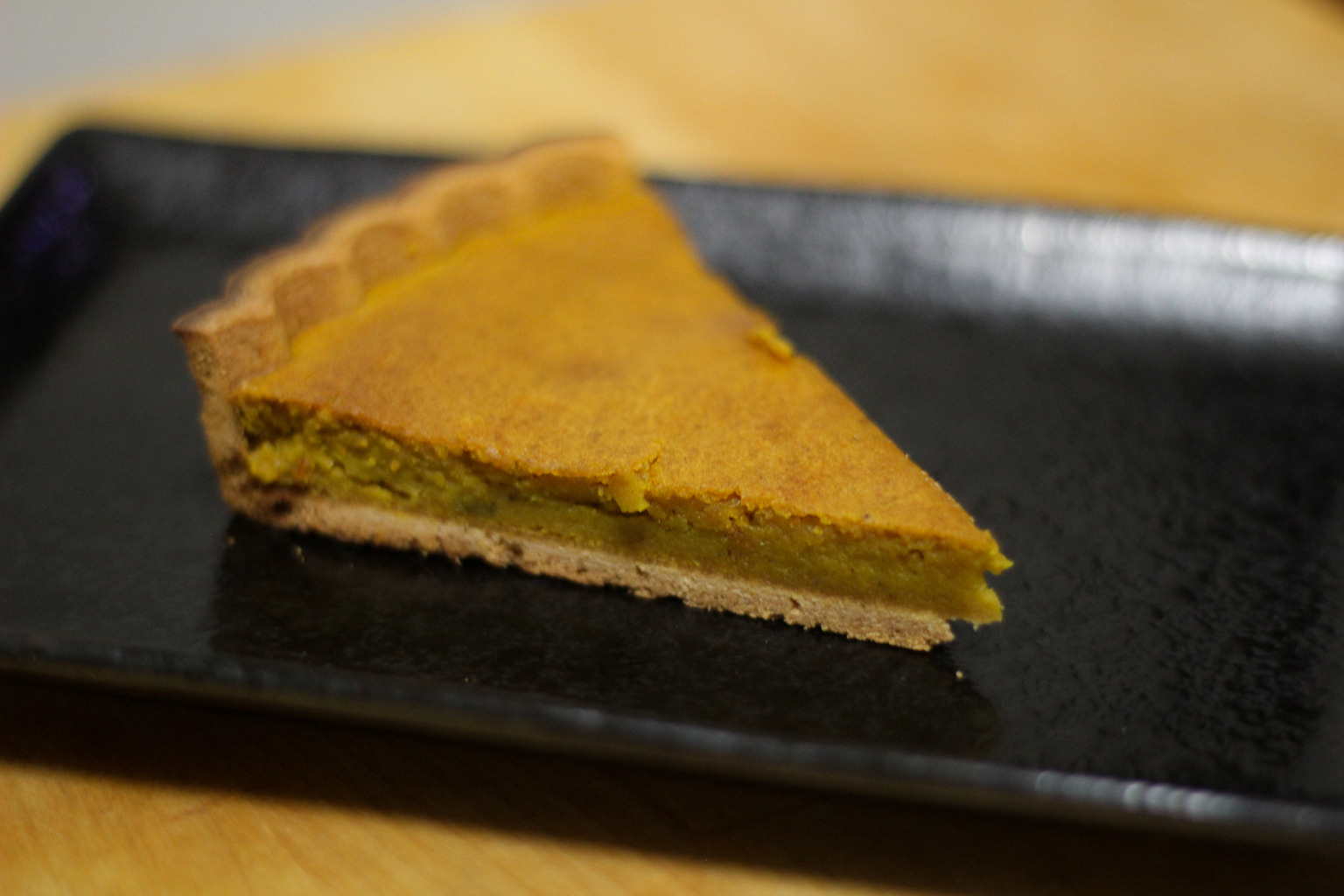
Place your filling your preferred crust, and for this demonstration we used store-bought crusts. For a classic American pumpkin pie we want a deeper dish than usual, and while a shallow dish is perfectly fine, the deeper dished pan will give you that classic American-style pumpkin pie we’re looking for. Plus it means more pumpkin pie per bite and who doesn’t love that.
For those using a deep pan, heat the oven to 170-180 degrees C° and place the pumpkin pie in the center. The pumpkin pie needs to cook at this temperature for around 45-55 minutes. If you’re using a shallower pie dish, lower the oven down to 160 degrees C° and cook the pumpkin pie for around 30-45 minutes.

Remove the pie from the oven and place on a cooling rack to cool for at least an hour, at this stage a little jiggle in your pie is OK, but keep an eye on it as it cools. Serve with ice cream, whipped cream or for the professional pie eater eat it directly from the pan.
Updated On August 16, 2021

